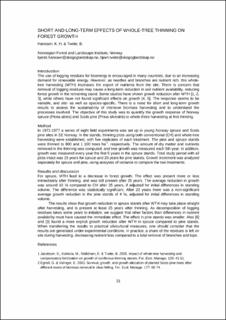| dc.description.abstract | The use of logging residues for bioenergy is encouraged in many countries, due to an increasing demand for renewable energy. However, there is concern that removal of logging residues may cause a long-term reduction in soil nutrient availability, reducing forest growth in the remaining stand. To quantify the growth response of Norway spruce and Scots pine to whole-three harvesting at first thinning a series of eight field experiments was set up in SE Norway in the seventies. Results after 25 years showed that whole-tree thinning lead to a decrease in forest growth. The effect was present more or less immediately after thinning, and was still present after 25 years. The average reduction in growth was around 10 % after 25 years in the spruce stands, while in the pine stands a non-significant average growth reduction of 4 % was found. The results are generated under experimental conditions, and in practice a share of the residues is left on site, decreasing the nutrient loss. | |
